Did you know that the average online shopping cart abandonment rate is a staggering 70.19%? That means nearly 7 out of 10 potential buyers leave without completing a purchase. For enterprises, this translates to millions of dollars in lost revenue. Why does this happen?
Today’s clients demand a seamless buying experience: 24/7 support, safe transactions, effortless navigation, and personalized assistance across their preferred channels. Many companies struggle to meet these expectations, driving consumers away.
Conversational commerce in retail is revolutionizing the way businesses interact with customers. It allows for real-time communication, offering instant answers, customized product recommendations, and a streamlined purchase experience.
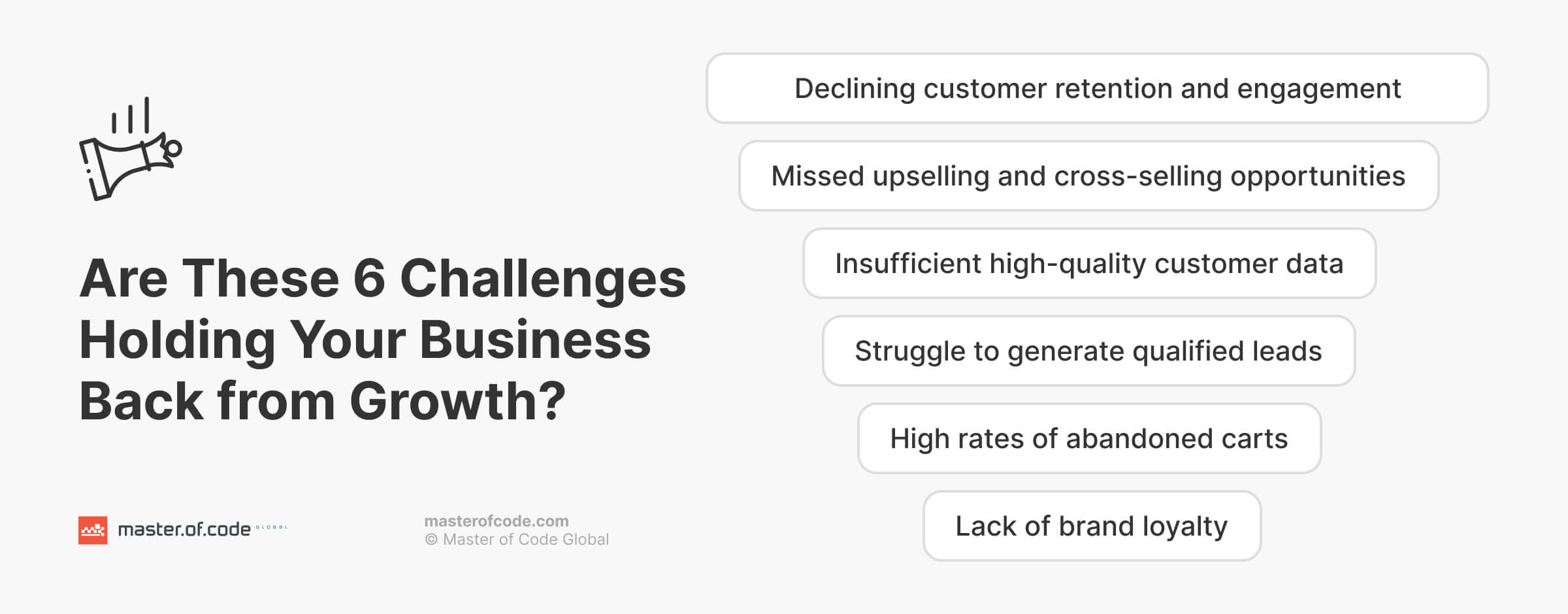
In this article, we’ll delve into 6 common business challenges and how AI provides powerful solutions. Don’t let your competitors gain the edge. Discover how conversational commerce for enterprises boosts customer engagement and drives sales growth. Start transforming your interactions and secure the bottom line.
Table of Contents
Problem 1: Missed Upselling and Cross-Selling Opportunities
Even with a loyal customer base, enterprises often miss out on significant but hidden revenue streams. Traditional sales techniques frequently rely on broad suggestions or promotions, lacking the personalization to maximize the value of each interaction. This leaves money on the table and limits the ability to fully understand and address evolving buyer’s needs.
With Conversational AI in retail, businesses get a chance to identify and capitalize on these overlooked possibilities. Powered by data analysis, AI-driven agents pinpoint prime moments within the existing user journey. Instead of generic offers, they find the perfect match for one’s needs based on past purchases, browsing behavior, and expressed interests. Such an individualized approach increases the likelihood of shoppers discovering relevant add-ons and upgrades. In the end, companies observe an increase in average order values. Let’s now see the technology in action.
Electronics Retail Chatbot
A top electronics manufacturer is taking a step forward in direct-to-consumer sales. They’ve successfully deployed a chatbot, co-developed by Master of Code Global and Infobip. The bot leverages Apple Messages for Business and is powered by Generative AI.
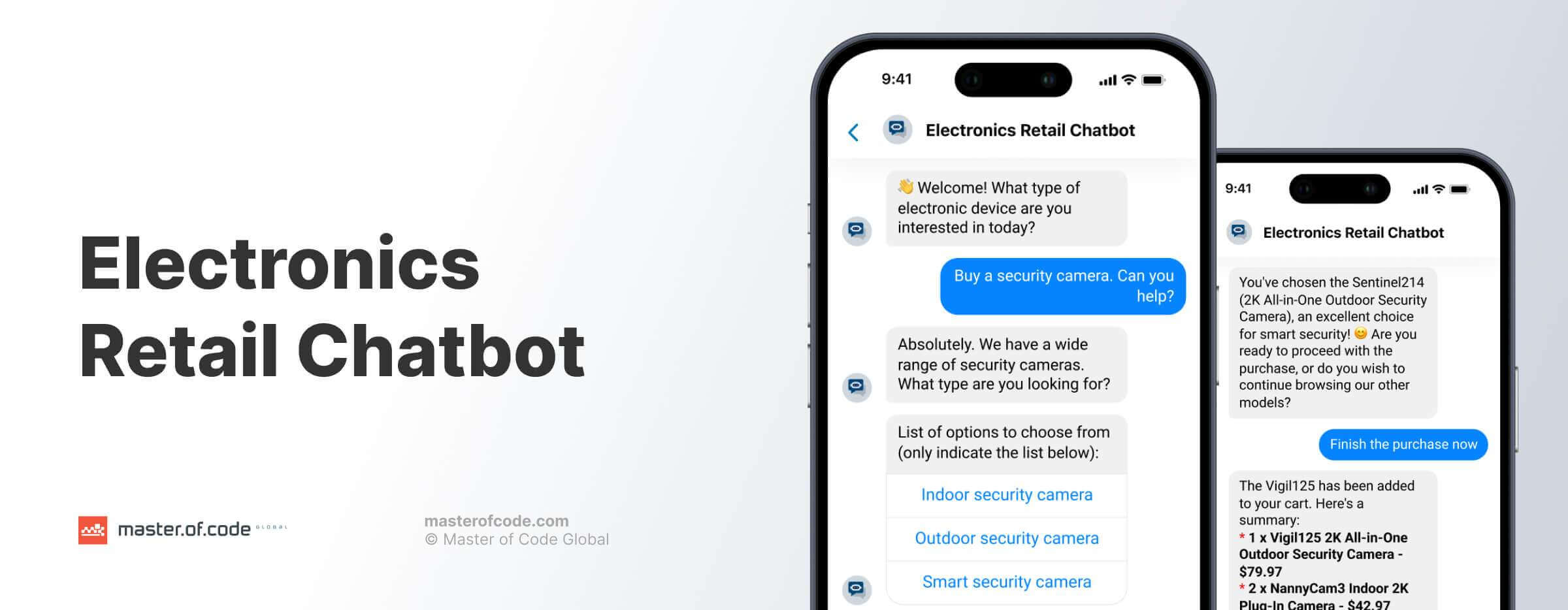
Thanks to Shopify store integration, customers can enjoy purchases directly through their messages. They get connected with ideal items and receive answers to complex product-related questions. This intelligent solution has maximized sales opportunities, leading to the following results:
- 80% CSAT score;
- 84% engaged session rate;
- ~$300 average order value.
Problem 2: Declining Retention and Engagement
For enterprises, customer churn is a persistent threat to profitability. Losing loyal clients not only erodes revenue streams but also directly impacts the consumer’s lifetime value. This forces businesses to invest heavily in acquiring new leads. Churn often arises from disengagement. Today’s buyers expect enterprises to anticipate their needs individually. When interactions feel generic or unhelpful, shoppers become disillusioned. This makes them more likely to seek solutions from competitors.
Conversational AI for customer engagement flips this narrative. It empowers companies to build genuine, long-term relationships instead of fleeting transactions. Chatbots and virtual assistants (VAs) powered by AI offer consistent, always-available assistance. They learn and adapt to user preferences over time. Consider it like having a dedicated, knowledgeable helper for each client: these tools can deliver proactive recommendations, personalize the experience, and foster a sense of loyalty that static FAQs or long support queues cannot match. And this isn’t just a theoretical benefit.
Giuseppe Virtual Assistant
Global brands like Dr. Oetker have successfully leveraged Conversational AI to boost engagement and ultimately drive sales. Their Giuseppe VA exemplifies this consumer-centric approach.
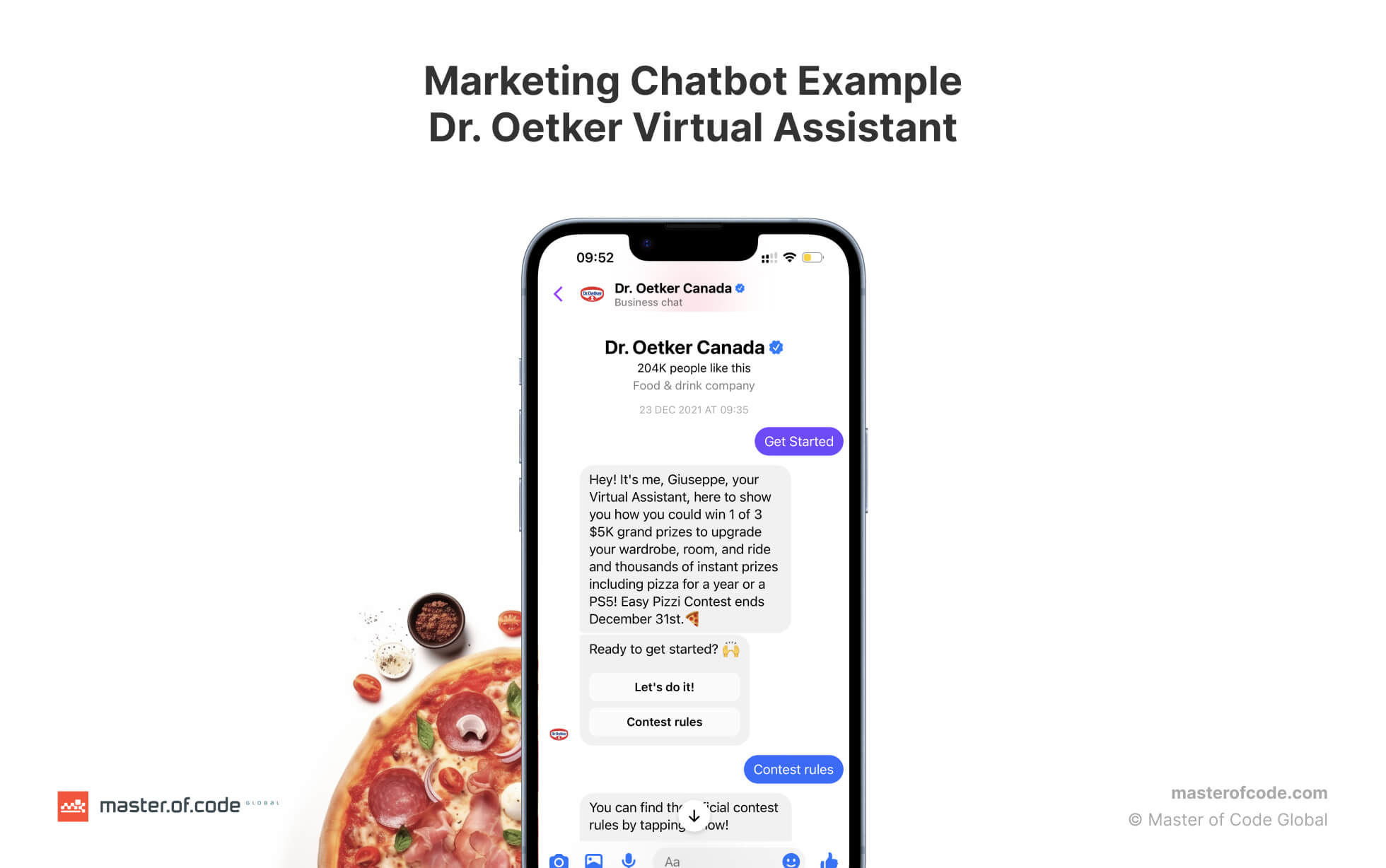
For the launch of their new Easy Pizzi product, the tool guided users through interactive contest registration, fielded questions, and even offered a fun AR experience to further solidify the connection. This personalized, multi-faceted method led to a surge in contest entries. Plus, it increased brand awareness and encouraged consumers to test their latest offering.
Problem 3: Insufficient High-Quality Customer Data
Without a deep understanding of their buyers, enterprises face significant challenges. Traditional data collection methods often provide only a surface-level view of preferences, behaviors, and pain points. This lack of details hinders effective targeting, outreach campaigns, and the ability to identify areas for improvement. In short, companies are unable to get the most out of the data they have, which ultimately stifles growth.
Conversational commerce has become a goldmine of valuable information. Chatbots and rich conversational interfaces go beyond simple form fills and surveys. They engage customers in natural dialogs, gathering their favorites, bottlenecks, and feedback in a way that feels organic and less intrusive. This wealth of actionable insights empowers businesses to modify their approach like never before. Enterprises can tailor marketing messages, create hyper-personalized suggestions, and make informed decisions to improve their products and services.
Luxury Escapes Messenger Chatbot
The brand, a leader in luxury travel, successfully leveraged an AI bot to enhance client data collection and find the perfect fit for each user. Their assistant guided visitors, helping them discover deals, share priorities, and complete bookings. The company then analyzed interactions to refine its targeting. The results were impressive:
- 3x higher conversion rate compared to their website;
- $300K+ revenue generated in the first 90 days;
- 89% reply rate for retargeting messages.
Problem 4: Struggle to Generate Qualified Leads
Acquiring new clients is the lifeblood of any enterprise, but the process is often fraught with challenges. Generating high volumes of leads isn’t enough. Businesses need qualified ones who are genuinely interested in their offerings. Traditional methods cast a wide net, wasting valuable resources on prospects with low conversion possibilities. The result: longer sales cycles, inefficient lead qualification, and missed growth opportunities.
Conversational marketing brings a fresh, laser-focused approach to the lead funnel. Instead of relying solely on static web forms, AI tools offer a proactive and dynamic touchpoint. Customers get engaged in real-time interactions, where they get all questions answered and concerns addressed. At the same time, the business gathers crucial information to determine the level of interest and potential fit of users. This allows sales teams to focus on high-value prospects, optimizing their workflow and resource allocation.
Feldman Automotive Group’s Bot
The dealership successfully incorporated a social media chatbot into their lead-generation strategy. This instrument targeted car shoppers within a specific radius around their showroom, engaging them through Facebook Messenger conversations. The AI-powered bot not only provided 24/7 customer support but effectively pre-qualified leads.
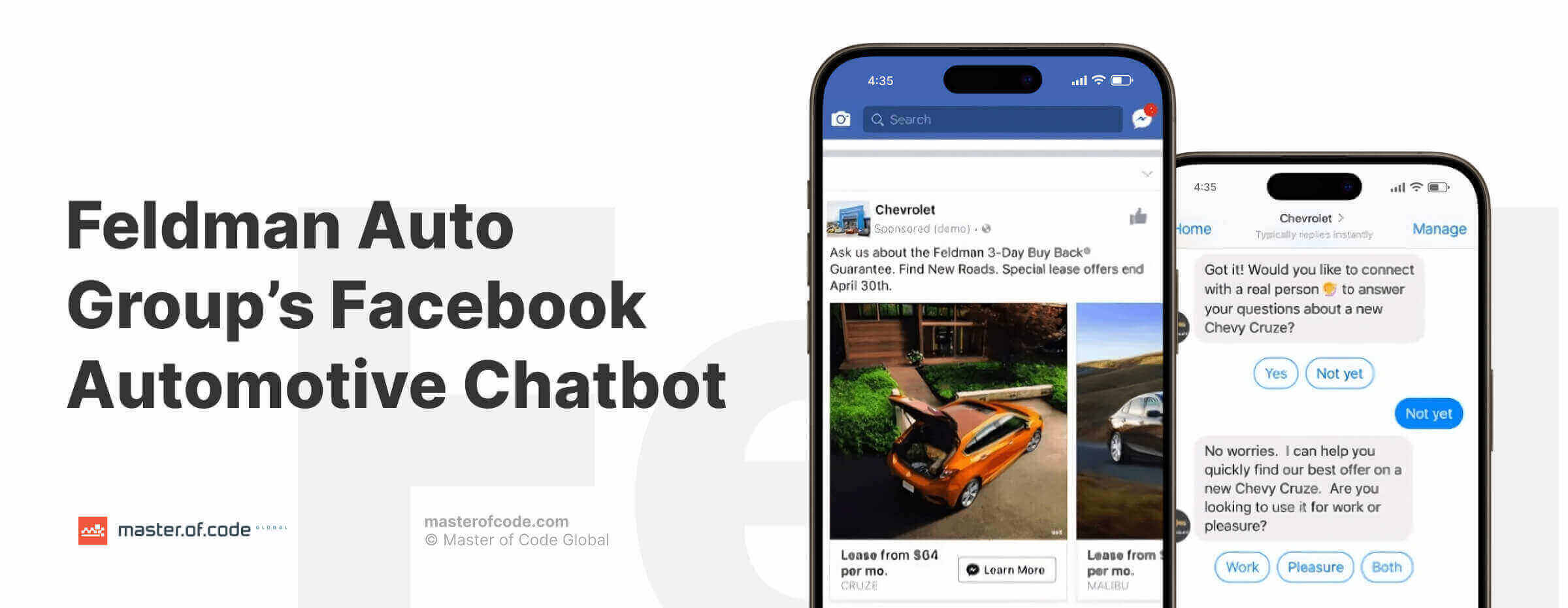
It achieved:
- Approximately 50 vehicle sales per month;
- Click-through rates between 4.5 – 5%, exceeding the auto industry average.
Read also: The Untold Benefits of Customer Acquisition Chatbots for Doubled Leads and Minimized Costs
Problem 5: High Rates of Abandoned Carts
Shoppers often place items into their carts with genuine intent but fail to finalize the purchase due to unexpected hurdles. Factors like hidden shipping costs, lengthy checkout processes, or technical glitches can cause consumers to leave without completing their transactions. Shopping cart abandonment is a pervasive issue for enterprises, a frustrating symptom of friction in the online purchasing experience. Eventually, the business faces a less-than-optimal return on investment.
Here’s where conversational commerce steps in to proactively address the matter. When a buyer shows signs of hesitation or tries to exit the site, a virtual assistant can intervene. It offers assistance, providing reassurance to customers who may have doubts. Clients get tailored discounts and details about shipping. AI can also facilitate the checkout process or even save a cart for later retrieval. Timely support removes friction, salvaging potential deals that may have otherwise been missed.
Dick’s Sporting Goods Predictive AI
The company made significant strides in combating this challenge by deploying an AI solution. Their system analyzes shopper behavior in real-time, allowing it to predict which consumers are at a high risk of abandonment.
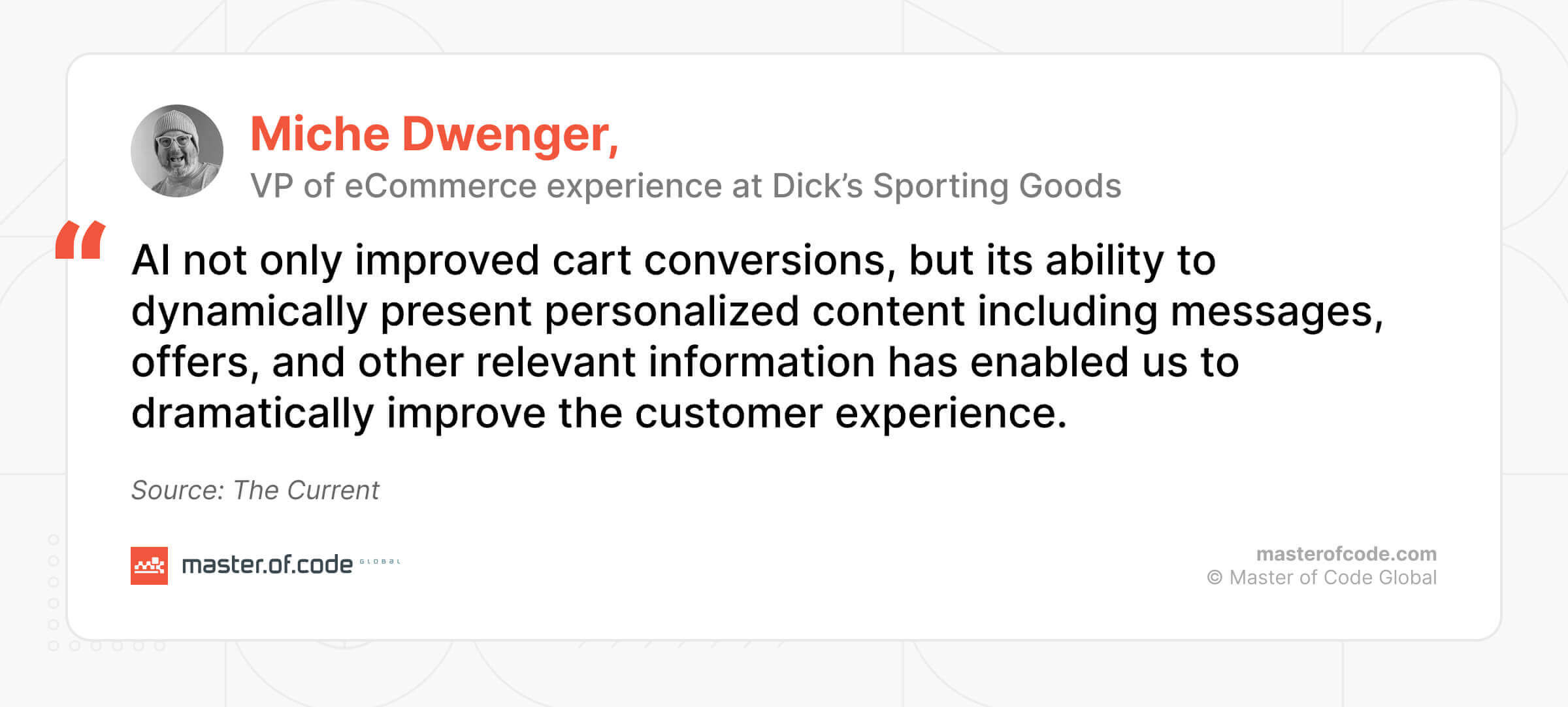
Armed with this knowledge, the tool dynamically tailors interventions, including customized messages, exclusive offers, and relevant product data. The enterprise significantly reduced the unfinished purchases rate and elevated client experience.
Problem 6: Lack of Brand Loyalty
In today’s competitive landscape, maintaining customer allegiance is more challenging than ever. Clients have a wealth of options at their fingertips, making them less hesitant to switch providers if their expectations aren’t met. This leaves enterprises vulnerable to competitors, forcing them to rely on price wars and unsustainable discounting tactics to retain consumers. Ultimately, it hinders the ability to build a strong, enduring brand that inspires genuine advocacy.
In this regard, chatbots and VAs can act as brand advocates, not simply order-takers. Conversational interfaces often incorporate interactive elements like quizzes, polls, and even simple games. They entertain users, boost trademark recall, and strengthen positive associations. Plus, AI can assist with proactive feedback and sentiment analysis. The data allows businesses to identify areas for improvement and demonstrate their commitment to buyer satisfaction. This cohesive approach builds trust and strengthens brand affinity.
Aveda’s Booking Assistant
An excellent example of the power of such solutions is Aveda’s bot. The company decided to prioritize the digital experience and simplify the reservation process. Their chatbot allowed clients to select the nearest store, book a complimentary beauty service, choose their preferred date and time, and confirm the appointment – all within one interface.

Such a level of care did not go unnoticed, and the business experienced:
- +378% growth in lifetime users from the campaign launch;
- 87% increase in total bookings;
- 33% conversion rate from the booking flow.
Wrapping Up
Having explored six powerful conversational commerce use cases, it’s clear that this technology is a must-have for businesses focused on exponential growth and expansion into new markets. From reducing cart abandonment rates and strengthening brand awareness to enhancing customer experience and driving higher conversions – these are just a few of the compelling advantages it offers.
As experts in Conversational AI services, we at Master of Code Global have witnessed firsthand the impact of chatbots and virtual assistants, as seen in the examples discussed. If you’re seeking a solution to address any of the six problems we’ve identified, we encourage you to explore the potential of conversational commerce. Contact us today for a personalized consultation on how we can tailor these solutions to your specific needs and roadblocks. Let’s partner to build a data-driven strategy for success.
Ready to build your own Conversational AI solution? Let’s chat!






